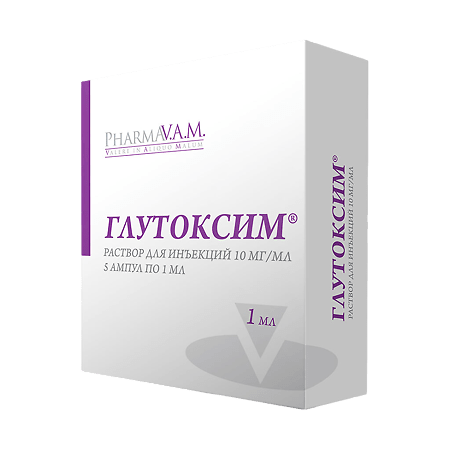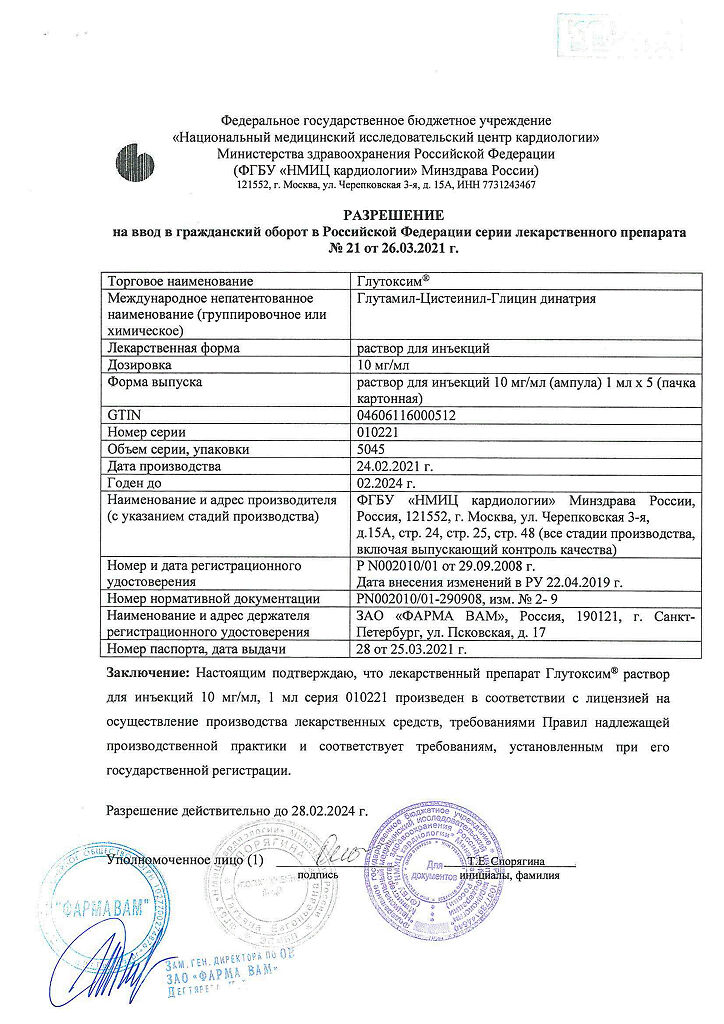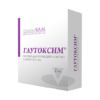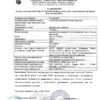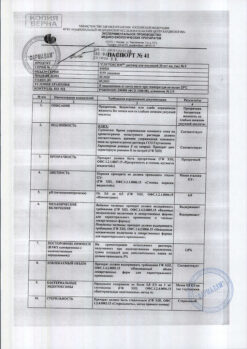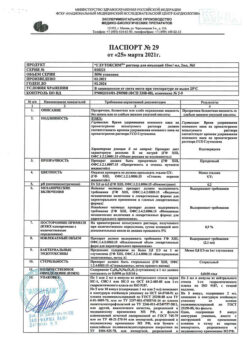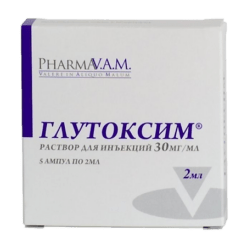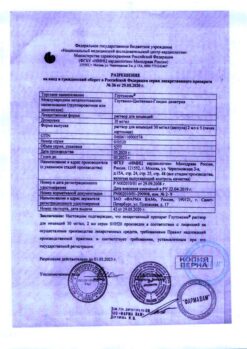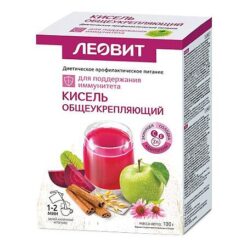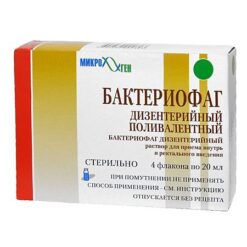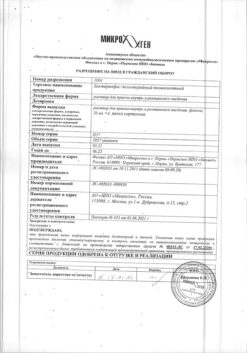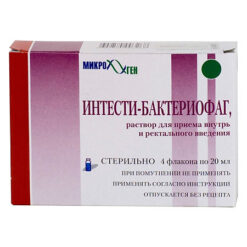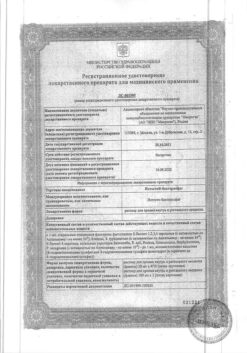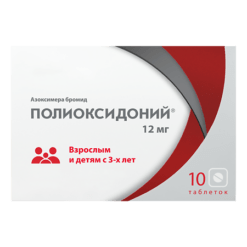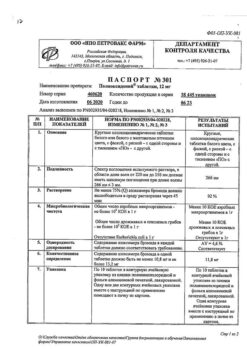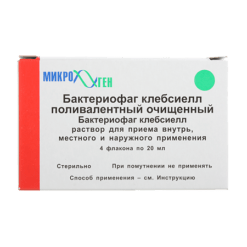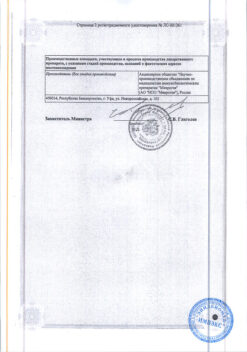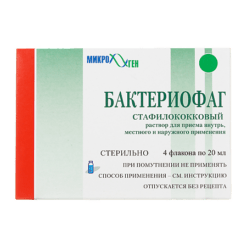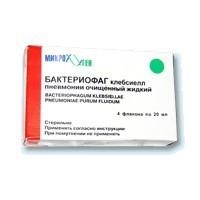No products in the cart.
Glutoxime, 10 mg/ml 1 ml 5 pcs
€33.11 €28.69
Description
Glutoxim – normalizing metabolic processes, regulating redox processes, immunostimulating.
It affects intracellular processes of thiol metabolism, redox state of cells. Immunomodulatory and systemic cytoprotective action is determined by new level of redox systems and dynamics of phosphorylation of key proteins of signal transduction systems and transcription factors (NFkB and AP-1), especially in immunocompetent cells.
It has differential effect on normal (stimulation of proliferation and differentiation) and transformed (induction of apoptosis – genetically programmed cell death) cells.
It has a high affinity to the cells of the central organs of immunity and the lymphoid tissue system, stimulates the processes of erythropoiesis, lymphopoiesis and granulocyte-monocytopoiesis, activates the phagocytosis system (including under immunodeficiency conditions.under conditions of immunodeficiency states), promotes restoration of neutrophils, monocytes, lymphocytes level in peripheral blood and functional activity of tissue macrophages.
It has stimulating effect on cascade mechanisms of phosphate modification of basic proteins of signal transduction systems; it causes initiation of cytokine system (including endogenous production of interleukin-1, interleukin-6, tumor necrosis factor, erythropoietin), reproducing the effects of interleukin-2 by induction of expression of its receptors.
The bioavailability is 90%. Time of reaching Cmax in intravenous administration – 2-5 minutes, in I/M – 7-10 minutes. Distribution in body organs and tissues: maximal accumulation – in liver, kidneys, immunogenesis and hematopoiesis organs, minimal – in adipose tissue. It is metabolized to amino acids. It is excreted by the kidneys as metabolites.
Indications
Indications
Secondary immunodeficiency conditions associated with radiation, chemical and infectious factors (prevention and treatment); restoration of immune reactions and bone marrow hematopoiesis, increasing the body’s resistance to various pathological influences – infectious agents, chemical and/or physical factors (including intoxication, radiation); ARVI, influenza, viral hepatitis (B and C), drug-induced hepatitis, metastatic liver lesions, hepatocellular carcinoma, alcoholic liver disease, urogenital infections, pulmonary tuberculosis, sepsis, autoimmune diseases; prevention of postoperative purulent complications; to increase the effectiveness of antibacterial therapy for chronic obstructive pulmonary diseases.
Pharmacological effect
Pharmacological effect
Glutoxim – normalizes metabolic processes, regulates redox processes, and immunostimulates.
It influences the intracellular processes of thiol metabolism and the redox state of cells. The immunomodulatory and systemic cytoprotective effect is determined by a new level of redox systems and the dynamics of phosphorylation of key proteins of signal-transmitting systems and transcription factors (NFkB and AP-1), primarily of immunocompetent cells.
It has a differentiated effect on normal (stimulation of proliferation and differentiation) and transformed (induction of apoptosis – genetically programmed cell death) cells.
It has a high affinity for the cells of the central organs of the immune system and the lymphoid tissue system; stimulates the processes of erythropoiesis, lymphopoiesis and granulocytomonocytopoiesis; activates the phagocytosis system (including in conditions of immunodeficiency states), promotes the restoration of the level of neutrophils, monocytes, lymphocytes and the functional activity of tissue macrophages in the peripheral blood.
It has a stimulating effect on the cascade mechanisms of phosphate modification of the main proteins of signal-transmitting systems; causes initiation of the cytokine system (including endogenous production of interleukin-1, interleukin-6, tumor necrosis factor, erythropoietin), reproduction of the effects of interleukin-2 through induction of the expression of its receptors.
Bioavailability is 90%. The time to reach Cmax with intravenous administration is 2–5 minutes, with intramuscular administration it is 7–10 minutes. Distribution across organs and tissues of the body: maximum accumulation – in the liver, kidneys, organs of immunogenesis and hematopoiesis, minimum – in adipose tissue. Metabolized to amino acids. Excreted by the kidneys in the form of metabolites.
Special instructions
Special instructions
Glutoxim® is a Russian innovative drug, a representative of a new class of drugs – regulators of the body’s defense systems (innate defense regulators, IDR). Drugs in this group, according to their pharmacological activity, belong to antibiotic adjuvants: the main effect of Glutoxim is the potentiation of anti-tuberculosis chemotherapy, incl. increasing the accessibility of Mycobacterium tuberculosis to the action of drugs and overcoming the drug resistance of the pathogen.
According to the results of fundamental and clinical studies, Glutoxim® enhances the secretion of endogenous antibiotics by macrophages – cationic antimicrobial peptides (CAP) (defensins and catalecidins), stimulates their absorption by mycobacteria. The action of CAP leads mainly to disruption of the structure and functions of the cytoplasmic membrane of the pathogen, which, in turn, leads to the death of the latter. The antibacterial activity of the drug Glutoxim® manifests itself when administered in vivo; for its implementation, it requires the presence of a pool of endogenous CAPs capable of mobilization, i.e., in relation to the action of the drug, CAPs act as effector molecules, predetermining its indirect antibacterial effect.
The effect of the drug is complemented by the effect of overcoming the drug resistance of Mycobacterium tuberculosis to isoniazid. Glutoxim® initiates the reaction of transformation of isoniazid (prodrug) into a pharmacologically active form – isonicotinic acid, which has an antimycobacterial effect against the pathogen, which makes it possible to overcome the drug resistance of Mycobacterium tuberculosis caused by the negative transformation of the katG (catalase-peroxidase gene) and inhA (enol-ACP reductase gene) genes. The effect of the drug is accompanied by an increase in the production of peroxynitrite and nitosoglutathione, compounds that have an independent bactericidal effect.
It has also been shown that Glutoxim® limits the possibilities of intracellular parasitism of Mycobacterium tuberculosis. The drug stimulates exocytosis (removal) of vesicles with intracellular parasitic mycobacteria from macrophages, ensuring their removal from the pharmacological refuge and making them available for the action of antibacterial drugs, including isoniazid, rifampicin, rifabutin, cycloserine, capreomycin, levofloxacin. The pharmacological effect of Glutoxim in relation to the antibacterial activity of the listed antibiotics is potentiating, as it increases the accessibility of the target (microorganisms) to the action of the drug.
Glutoxim® increases the frequency of cessation of bacterial excretion and reduces the time of sputum abacillation. By the end of the 2nd month of treatment, among patients receiving Glutoxim®, bacterial excretion ceased in 91.1% of patients with drug-sensitive tuberculosis (vs 61.1% in the control group) and in 75.1% of patients with drug-resistant tuberculosis (vs 38.9% in control) (p® the time for resorption of infiltrative and focal changes in the lungs is reduced: by the end 2nd month of treatment, resorption of infiltrative and focal changes was detected in 93.2% of patients who received Glutoxim® along with chemotherapy (vs 62.2% of patients in the control group) (р® (vs 70.8% of patients in the control group) (р
Glutoxim® improves the tolerability of anti-tuberculosis chemotherapy: toxic reactions (increased activity of ALT, AST, bilirubin, creatinine in the blood serum) were observed only in 4.3% of patients, while in the control group – in 11.1% of patients (p®) were observed significantly less often – in 6.4% of patients, while 20% in the control group (p®), were stopped mainly in the first 2 months of treatment. Glutoxim® prevents exacerbation of chronic hepatitis during chemotherapy for tuberculosis, and in case of already developed drug-induced liver damage, it allows chemotherapy to be continued in full without resorting to its temporary cancellation. Glutoxim® reduces the incidence of toxic hepatitis by more than 4 times.
Glutoxim® in combination with chemotherapy makes it possible to quickly prepare patients for surgical treatment – the drug increases the frequency of sputum abacillation and promotes the disappearance or significant reduction in the frequency and intensity of clinical and laboratory symptoms of the disease in patients undergoing surgical treatment. In patients with drug-resistant tuberculosis who received Glutoxim® along with anti-tuberculosis chemotherapy in the preoperative period, positive dynamics of clinical and laboratory symptoms of the disease were observed 2 times more often (59.6% vs 28.9%), cessation of bacterial excretion was observed 1.9 times more often (38.3% vs 20% in the control). Glutoxim® improves the immediate results of surgical treatment. Restoration of pneumatization of the lung tissue by the 21st day of the postoperative period occurs in 82% of patients who received Glutoxim® along with anti-tuberculosis chemotherapy, and only in 35% of patients who received chemotherapy alone. Postoperative complications (pleural empyema, progression of a specific process, nonspecific pneumonia) in patients receiving Glutoxim® developed 4.5 times less often (6.9% vs 32%) than in patients receiving only chemotherapy (p®, they were 1.5 times shorter and amounted to 42.1±1.7 bed days, and in patients receiving only chemotherapy – 62.3±8.1 bed days (p
Glutoxim® improves the tolerability of chemotherapy, radiation and chemoradiotherapy in oncology. Glutoxim® restores the sensitivity of stem cell receptors to endogenous and exogenous colony-stimulating factors and erythropoietins, suppressed by chemotherapy and cancer intoxication. Thanks to this, the leukocyte, platelet and erythrocyte lineages of hematopoiesis are restored. The drug can reduce the incidence of leukopenia and thrombocytopenia or shift severe hematological toxicity to the moderate region. The addition of Glutoxim during chemotherapy in patients with morphologically confirmed stage IIIb-IV NSCLC according to the etoposide + cisplatin regimen, who had not previously received chemotherapy and radiation therapy, made it possible to reduce the incidence of deep neutropenia (WHO toxicity grades 3 and 4) by 2.5 times (p = 0.002), the incidence of general thrombocytopenia by 1.6 times (p
Glutoxim® helps prevent or reduce the severity of reactions of the skin (dermatitis) and mucous membranes (mucositis, stomatitis, rectitis, cervicitis) to radiation and the effects of chemotherapy. Complications in the form of early radiation rectitis in patients with stage III cervical cancer during the use of the drug Glutoxim® develop less frequently (6.15% vs 16.0%), restoration of the functions of the pelvic organs occurs faster (r® in patients with tumors of the oropharyngeal region contributes to a significant reduction in the severity of subjective manifestations of radioepithelitis – the incidence of bleeding gums and the occurrence of focal epitheliitis is significantly reduced. The frequency of complaints such as dryness in the mouth has decreased. mouth, pain when swallowing, change in taste.
Glutoxim® helps to improve or maintain the quality of life of patients receiving chemotherapy/RT and provides the opportunity to carry out all required courses of chemotherapy. In patients with tumors of the oropharyngeal region of stage III-IV who received radiation therapy, Glutoxim® helps restore the quality of life – the Karnofsky index increases to 90% (with 50-60% in the control) (p® promotes chemotherapy, radiation and chemoradiotherapy in full, without reducing the planned courses. Clinical studies have demonstrated an increase in the frequency of positive responses to a radical course of radiation therapy for locally advanced cervical cancer uterus. The rate of achieving complete remission was 77% (in the control group – 38%). A faster recovery of peripheral blood parameters and an improvement in the general condition of patients during radiation therapy were noted.
Glutoxim® helps to increase the frequency of complete (including morphological) remission and relapse-free survival. The frequency of positive responses to radiation therapy in patients with stage III-IV oropharyngeal cancer (complete + partial remission) in the group of patients receiving Glutoxim® was significantly higher than in the control group – 83.4% and 61.5%, respectively. In patients with HER-2(-) stage II-III breast cancer, the addition of Glutoxim® to neoadjuvant therapy led to a doubling of the previously achieved rate of complete morphological remission. In chemotherapy of patients with platinum-resistant ovarian cancer with the inclusion of the drug Glutoxim®, the median relapse-free survival was 15.4 weeks, while without the use of the drug, according to historical control, this figure was 8 weeks in patients with the same intensity of treatment. The average disease-free survival period was 19.4 weeks. The inclusion of the drug Glutoxim® in the chemotherapy regimen showed clinical feasibility (complete remission + partial remission + stabilization) in 60% of patients.
When Glutoxim® was prescribed to patients with psoriasis, according to the results of clinical studies, patients experienced a more rapid (on the 5-6th day of therapy) and complete regression of rashes (infiltration, peeling, swelling), itching decreased and the quality of life improved: the PASI index decreased from 39.5±4.0 to 11.7±5.2, while in patients receiving standard therapy – with 26.1±2.6 only up to 21.0±2.9 (p® demonstrated hepatoprotective and toxicomodifying effects: after 7-10 days of therapy there was a decrease in liver symptoms – pain and/or heaviness in the right hypochondrium decreased or stopped, ALT transaminase levels normalized from 65.9 ± 34.5 U/l to 45.9 ± 15.0, AST from 98.1±25.4 U/l to 45.5±13.4 U/l (p®) the period of remission was within 6 months – in 19% of patients, within a year – in 20.8% of patients, more than 1 year – in 51.2% of patients, 1.5 years or more – in 9% of patients.
As part of complex therapy for sexually transmitted infections, Glutoxim®, as an antibiotic adjuvant, helps to increase the effectiveness (potentiation) of etiotropic antibacterial therapy for urogenital infections (UGI), one of the factors in the formation of profound reproductive disorders (including infertility), and reduces the risk of subsequent relapses of UGI. According to the results of clinical studies, the effectiveness of UGI therapy 1 month after the end of treatment according to PCR results (elimination of the pathogen) in the group of patients who received only antibacterial therapy was 64.5-73.6%, and in the group who received Glutoxim® along with antibacterial therapy – 97.4%-98.7%. When Glutoxim® was included in the regimen, relapses of infection were also detected significantly less frequently, and there was a decrease in the likelihood of recurrent UGI development (with re-infection or reinfection) during the 12 months of observation following therapy.
Glutoxim® helps to increase the effectiveness of complex therapy for chronic inflammatory diseases of the internal genital organs of women. The inclusion of the drug Glutoxim® in treatment regimens for chronic inflammation of the internal genital organs in women of reproductive age increases the effectiveness of treatment. There is a restoration of the function of the immune system, incl. at the local level: activation and normalization of nonspecific protection indicators occurs – for example, the concentration of secretory IgA and IgA of cervical mucus. Manifestations of the inflammatory reaction are stopped (rapid regression of pain during the first 7 days), there is an improvement in the quality of life of patients and stable clinical recovery in 96.8% of patients.
Glutoxim® helps to increase the effectiveness of complex therapy for chronic inflammatory diseases of the male genital organs, incl. complicated by excretory toxic infertility. As a result of studies of the effectiveness of including the drug Glutoxim® in treatment regimens, a pronounced anti-inflammatory effect was revealed: with light microscopy of prostate secretions before treatment, leukocytes were 91.3 ± 11.2 in the field of view, after treatment – a decrease to 11.9 ± 1.8 (p® in treatment regimens for chronic bacterial prostatitis (CKD) reduces the treatment time to 3 weeks (versus the standard 4-6 weeks). In complex therapy of CKD in combination with UGI, the inclusion of the drug Glutoxim® can increase the period of remission and reduce the frequency of relapses by 3 times. The inclusion of the drug Glutoxim® in treatment regimens for CKD helps to improve the erectile and ejaculatory components of the copulatory cycle of a man.
Active ingredient
Active ingredient
Glutoxim, Glutamyl-Cysteinyl-Glycine disodium
Composition
Composition
Active ingredient:
glutamyl-cysteinyl-glycine disodium;
Excipients:
sodium acetate,
acetic acid (diluted to pH 6.0),
water d/i.
Pregnancy
Pregnancy
Clinical studies of the use of the drug Glutoxim® during pregnancy and lactation (breastfeeding) have not been conducted.
Contraindications
Contraindications
Hypersensitivity, pregnancy, breastfeeding.
Side Effects
Side Effects
Low-grade fever, pain at the injection site.
Interaction
Interaction
Glutoxim®, when used in combination, potentiates the bacteriostatic effect of isoniazid, rifampicin, rifabutin, cycloserine, capreomycin, levofloxacin on Mycobacterium tuberculosis, the anthracycline antibiotic doxorubicin, and the alkylating agent etoposide on tumor cells.
Glutoxim® reduces the therapeutic effect of nifedipine and verapamil.
Inhibitors of the cyclooxygenase pathway of arachidonic acid oxidation – indomethacin, meloxicam – reduce or completely suppress the pharmacological effect of the drug Glutoxim®.
An isotonic sodium chloride solution or a 5% glucose solution is used as a carrier solution for infusion administration.
Overdose
Overdose
Currently, no cases of overdose of Glutoxim® have been reported.
Storage conditions
Storage conditions
In a place protected from light, at a temperature not exceeding 25 °C
Shelf life
Shelf life
2 years
Manufacturer
Manufacturer
Pharma VAM, Russia
Additional information
| Shelf life | 2 years |
|---|---|
| Conditions of storage | In a light-protected place, at a temperature not exceeding 25 °C |
| Manufacturer | Pharma VAM, Russia |
| Medication form | solution for injection |
| Brand | Pharma VAM |
Other forms…
Related products
Buy Glutoxime, 10 mg/ml 1 ml 5 pcs with delivery to USA, UK, Europe and over 120 other countries.

